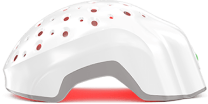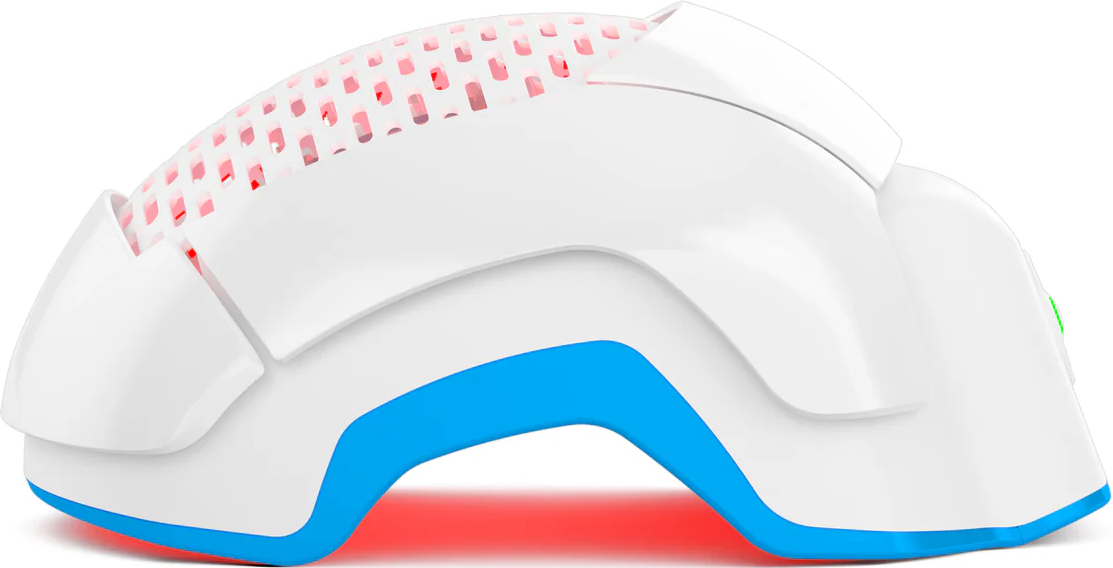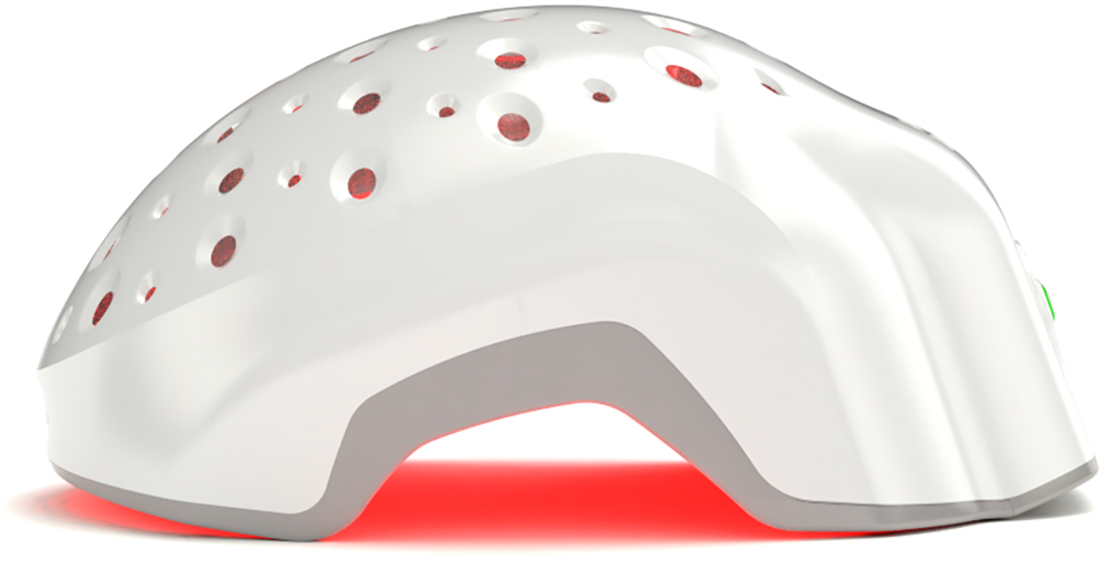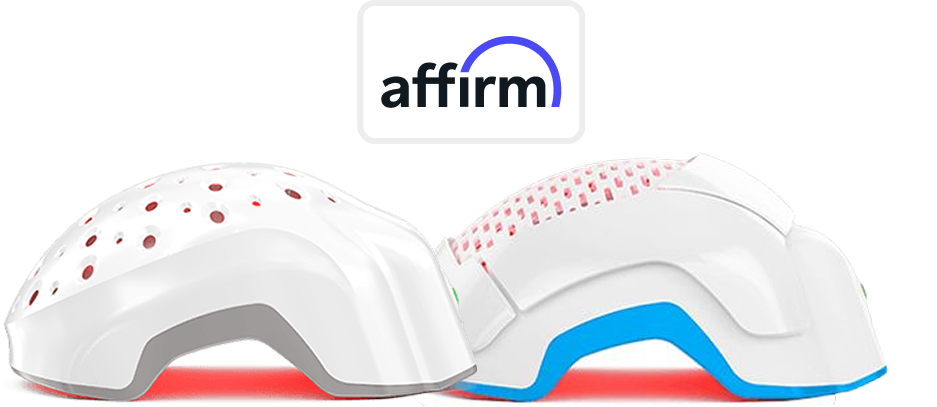Hair thinning doesn’t just alter your reflection—it quietly tugs at confidence. What if, instead of pills or pricey procedures, you could biohack your hair with a helmet that gently bathes your scalp in red light?
Laser phototherapy (LPT)… yes, that’s cold laser tech that’s safe and science‑backed. (The low‑power light that nudges your hair‑root cells into action.)
We’ll take you through the future of laser phototherapy—what it is, why it’s gaining traction as a biohacking tool, how real the science is, and whether it can truly help with early androgenetic alopecia.
This blog will answer the big questions:
- What really happens inside a follicle under red‑light photons?
- Do credible studies confirm actual regrowth?
- How does it compare to traditional treatments—or synergy with them?
And yes, we’ll show how wearable devices like Theradome should shape the future. Could this be the simplest non‑drug regimen to reclaim not just hair but a little confidence back?
What Exactly is Laser Phototherapy for Hair Loss?
Laser phototherapy (LPT) refers to cold‑laser (Class 3R) devices emitting red or near-infrared wavelengths, typically 600–1000 nm. These are low‑power (under five milliwatts) so there's no heat, no burning. Just photons interacting with your scalp tissue.
Mechanistically, it’s about photobiostimulation. Light photons penetrate follicles, energize mitochondrial cytochrome‑c‑oxidase, boost ATP production, and trigger mild oxidative signaling. This nudges hair into a more active growth phase and may halt or even reverse miniaturized follicles characteristic of early-stage androgenetic alopecia.
Theradome (and similar FDA‑cleared devices) deliver controlled doses of laser energy to optimize follicle stimulation, avoiding randomness. In effect, that dose matters: too little yields no result, too much... well, with Class 3R, there’s still no burns, but there's no extra benefit either.
Also Read: How Laser Phototherapy Helps Stop Hair Loss and Support Hair Growth?
Why Hair Loss Happens and Where Lasers Fit?
Most readers will be dealing with androgenetic alopecia (pattern hair loss). In such cases, hair follicles gradually shrink, strands thin, and shedding increases. LPT is best suited for those early–mid stage cases, where follicles aren’t completely dormant.
Other types—telogen effluvium (stress‑related shedding) or cicatricial alopecia (scarring)—may benefit too, though evidence is preliminary. Jafari et al. (2024) observed some use in cicatricial cases, while impact on telogen effluvium remains less clear.
Importantly: LPT is not a miracle cure—but it’s a proactive regimen, especially if you're biohacking for longevity. And yes, there’s overlap with lifestyle basics (nutrition, stress reduction, sleep) but those are add-ons, not replacements.
Science & Evidence: Do Laser Devices Actually Work?
Several randomized, double‑blind trials (RCTs) using FDA‑cleared devices show statistically significant hair improvements versus sham treatments.
-
Leavitt et al. (2009): 110 participants used the HairMax LaserComb three times a week for 26 weeks. Terminal hair density rose significantly vs sham. No serious adverse effects.
-
Jimenez et al. (2014): Involving 128 men and 141 women, the study again saw meaningful increases in thickness and fullness across both genders, regardless of age. Subjective satisfaction rose too.
-
Lueangarun et al. (2021 Meta‑analysis): Analyzed seven RCTs and found a standardized mean difference (SMD) of 1.27 in hair density favoring active treatment compared to placebo. That’s a robust effect size.
These are controlled, peer‑reviewed results. And consistency matters. Multiple devices, different populations, three separate trials all align.
Quantitatively: users often see 20–40% increases in hair count or density, with fullness becoming noticeable within 3–6 months under consistent use.
Laser Phototherapy as a Biohacking Tool
Somewhere between biohacking podcasts and Reddit hair‑loss forums, LPT found its second identity as a daily ritual for self‑optimizers.
Why? Because LPT doesn’t feel clinical. It’s non‑invasive, at‑home, and plays into the quantified‑self culture. Wear the helmet, track your weekly usage, maybe even sync it with a smart mirror.
And biohackers don’t just want more hair. They want control. They crave interventions that bend biology subtly, in their favor, without relying solely on pharmaceuticals. LPT fits this ethos… it’s low‑risk, measurable, and pairs beautifully with lifestyle data.
The Psychological Angle
There’s a peculiar emotional layer here. Sliding on a laser helmet feels, well, futuristic. Like stepping into your own sci‑fi lab. It’s one thing to swallow a pill passively; it’s another to actively beam energy into dormant follicles.
This motivation sustains consistency, and consistency is what powers any LPT protocol. Biohacking thrives on feedback loops… visible results and the quiet thrill of tech‑meets‑biology.
Best Practices for Biohacking with LPT
-
Frequency & Discipline: Most studies land around 20 minutes, 3–4 times a week. Miss sessions, and the results decline.
-
Stacking With Lifestyle: Proper protein intake, micronutrients, and stress mitigation reinforce follicular energy.
-
Data Tracking: Before/after photos, hair density checks… your brain loves metrics.
This is structured self‑experimentation, which is why the wearable nature of LPT draws such a passionate micro‑community. You can almost imagine a future where smart helmets log data to an app for real‑time hair analytics.
Combination Therapies and Synergistic Strategies
Truth is, LPT alone works best in early to mid‑stage cases. But its magic shines brighter in synergy.
It’s like a gym routine. One exercise helps, but a well‑combined plan transforms results.
-
Minoxidil + LPT: Probably the most cited pairing. Minoxidil drives follicle blood flow and anagen phase stimulation, while lasers boost mitochondrial energy. The 2022 meta‑review by Gupta & Lyons noted a ~40% higher density improvement with the combo than either alone.
-
Finasteride + LPT: The hormonal angle and bioenergetics. This pairing works well for men, but it’s more of a physician‑guided route.
-
PRP + LPT: Platelet‑rich plasma adds a growth factor punch; LPT might extend PRP’s effects by energizing follicles post‑treatment.
Another unexpected synergy is stress reduction. A 2023 user‑survey hinted that pairing meditation with laser sessions (yes, literally sitting still and breathing) improved adherence and user satisfaction. Maybe the parasympathetic activation aids scalp perfusion. Or maybe it just feels nice.
Layering without Overcomplicating
The art is not to stack endlessly. A simple framework:
-
Foundation: Nutrition + scalp health
-
Stimulation: LPT, 3–4 sessions/week
-
Optional Boosters: Minoxidil, PRP, or physician‑approved meds
Even lifestyle tweaks (good sleep, avoiding chronic tension) matter more than many assume. Remember, biohacking is rarely about one single gadget.
Would a future device integrate multi‑modal therapy? Imagine a helmet that pulses light, cools the scalp, and maybe diffuses a micro‑dose of botanical DHT blockers. Sounds wild… but three years ago, so did strapping on a light‑emitting dome.
Emerging Frontiers & The Future of Laser Phototherapy
The fun part is… we’re still at the start line of LPT innovation.
Current devices are basically standalone lasers in a shell. But next‑gen LPT could involve adaptive intensity, scalp‑mapping AI, or multi‑wavelength fusion for specific follicle profiles. Imagine an app analyzing your density map, then auto‑tuning photon delivery.
Then there’s cross‑tech synergy:
-
Photothermal + Photobiomodulation hybrids for stubborn follicles
-
Microcurrent‑enhanced helmets to stimulate blood flow simultaneously
-
Smart diagnostic feedback: scalp sebum, hydration, and follicle health readings in real time
One speculative angle is Chronobiology. Follicles have circadian rhythms. Could timing sessions to your body clock amplify growth? Early studies in mice hint at phototherapy‑circadian interplay, but human trials are pending.
From Clinics to Living Rooms—and Beyond
Theradome’s consumer launch was a watershed moment. The shift from clinical dependency to living‑room autonomy is what unlocked LPT’s biohacking identity. Future devices might shrink further, like lightweight bands, or even flexible photonic fabrics you wear under a cap.
And let’s not ignore cost curves. Prices are slowly dropping. Within a decade, LPT might be as routine (and unremarkable) as an electric toothbrush. Perhaps even bundled with AR scalp‑visualizers. (Yes, slightly absurd… but trends suggest otherwise.)
Why This Future Matters
Because hair loss touches self‑image, confidence, and subtle psychosocial threads. LPT occupies that rare middle zone: scientifically plausible, psychologically uplifting, and culturally aligned with self‑directed health.
The next frontier is not just more photons—it’s integration. Data‑driven personalization, minimal friction, emotional engagement. A future where hair care quietly evolves into a daily, almost meditative, bio‑ritual.
Would we call that science… or art? Maybe both.
Ethical Considerations
So, where does all this shimmering talk of photons and mitochondria leave an everyday biohacker… or frankly, anyone with a passing interest in human optimization?
First, the practical side: low-level laser phototherapy (LLLT) isn’t just a lab curiosity anymore. Affordable home devices exist, though quality varies wildly (and no, not every glowing gadget on social media is legitimate). Start small, track responses, and resist the temptation to overdo sessions. Cells need rest cycles, too.
Now for the trickier part—ethics. Should we all be shining coherent light on our skin and brains like it’s the new meditation?
Maybe… but pause. Accessibility, equity, and safety linger as unresolved shadows. Certain wavelengths can risk retinal damage if misused, and not all claims in the biohacking sphere hold water. Imagine a world where only the affluent amplify cognitive performance while others wait for peer-reviewed guidance. It’s… a little dystopian, isn’t it?
One practical suggestion (call it common sense, which is rarer than we admit): combine curiosity with caution. Document outcomes. Cross-check manufacturer claims. And perhaps, check in with actual healthcare professionals.
Sometimes, the most advanced biohack is patience. Oddly enough, that’s the part most of us skip.
Conclusion
Laser phototherapy stands at a strange, almost liminal crossroads… part medical science, part biohacker playground. Its potential to accelerate tissue repair, modulate inflammation, and maybe even tune brain performance is undeniably fascinating. But fascination is not the same as proof, and hype travels faster than rigor.
If there’s a single takeaway, it might be this: technology rarely replaces intentional living. Light can trigger cells, yet sleep, movement, and meaningful habits still form the louder chorus of health.
Will the future bring home lasers as ordinary as electric toothbrushes? Possibly. Or we might discover that restraint (not intensity) was the real leap forward. Either way, the journey is just beginning, and like photons bouncing through tissue, our curiosity keeps scattering into new and unpredictable paths.






















